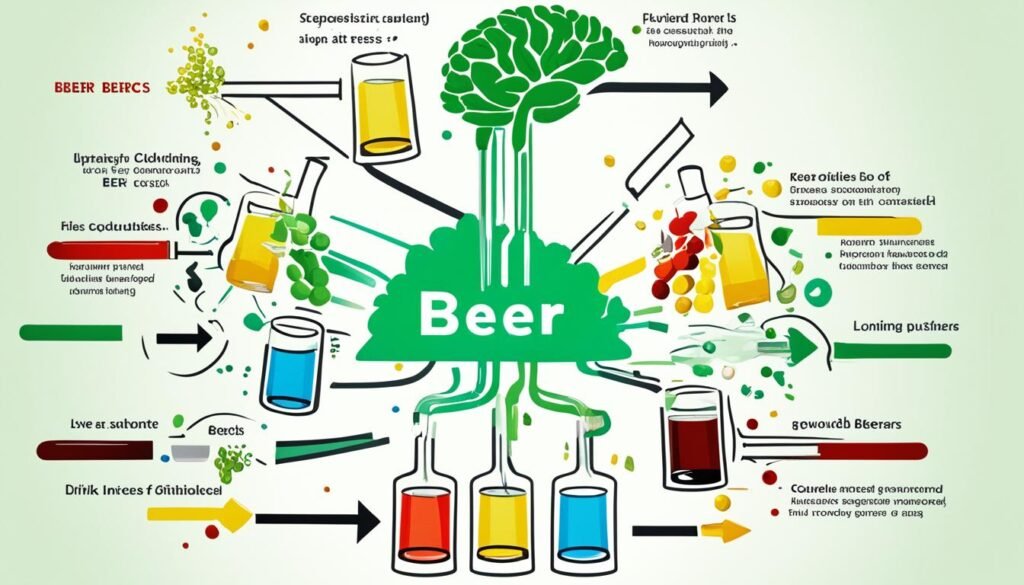The quintessential social beverage, beer is a staple at gatherings and events, yet its impact on health is frequently underestimated. Synonymous with relaxation and camaraderie, beer’s innocuous reputation belies its potential for causing liver damage and contributing to alcoholic liver disease when indulged in excessively. While an occasional pint may pose little concern, excessive drinking on a daily basis can compromise liver health with alarming swiftness.
Moderate beer consumption has been touted for potential health benefits, such as increased bone density. However, these positives are vastly overshadowed by the risks associated with high-volume intake, particularly concerning the liver – the body’s paramount detoxifier. When faced with more alcohol than it can effectively process, the liver is driven towards an overstressed state, susceptible to lasting harm.
Key Takeaways
- Even moderate levels of daily beer consumption can disrupt crucial cognitive functions and sleep patterns.
- The liver has a limited capacity to metabolize alcohol; exceeding this capacity can lead to stressed liver function.
- Excessive alcohol intake inflames the gastrointestinal tract and disrupts gut health, increasing the risk of diseases like fatty liver.
- The cumulative effect of daily drinking can outweigh the mild diuretic effect of beer, posing dehydration concerns.
- Adherence to safe drinking guidelines is critical to reduce the risk of alcoholic liver disease and other health complications.
- Responsible consumption is key; the risks of liver damage due to excessive drinking significantly outweigh any minor benefits of beer.
Understanding Beer Consumption and Liver Health
The burgeoning U.S. beer industry serves as a testament to the country’s deep-seated affinity for this time-honored beverage, with significant annual revenue figures illuminating the extent of beer consumption nationally. However, beyond the cultural tapestry that beer weaves, it brings to the fore critical discussions about liver health and the consequences of indulgence. As patrons frequent a variety of venues to enjoy a cold brew, perhaps too seldom is the tale of moderation over excess championed—a cautionary note that echoes through the realms of healthcare.
Each serving of beer holds more than just the promise of temporary reprieve or celebration; it heralds a tally of calories, carbohydrates, and most critically, alcohol—each vying for the liver’s attention. The process of metabolizing alcohol can dominate the liver’s list of priorities, inadvertently hampering the metabolic rate of fat oxidation, thereby affecting weight management efforts. The incidence of such metabolic interference accentuates the fine line between leisurely drinking and inadvertent excess.
When moderate drinking evolves into a routine of consumption that outweighs the advised limits, the liver transmutes from a silent processor to an overwrought filter, battling the toxic onslaught imposed by increased alcohol levels. As such, an overtaxed liver manifests the early chapters of strain and sets the stage for potential long-term repercussions, embodied as cellular damage that could have been sidestepped with heedful consumption habits.
The art of moderation is enshrined in dietary guidelines that espouse a maximum of two drinks per day for men and a singular drink for women. It is no mere directive but a blueprint for the preservation of not just liver health, but also systemic wellness. Drink, but let the drink not rule thee—a modern refrain to an age-old adage, prescribing a salve for health that is both literal and liberatory.
- Caloric and alcohol intake: Each beer adds to one’s daily caloric load, but the alcohol content requires particular scrutiny for its impact on the liver.
- Toxin filtration: The liver’s function as a filtration system for toxins, including ethyl alcohol, becomes increasingly burdened with higher consumption rates.
- Dietary guidelines and consumption: Adherence to the prescribed guidelines is pivotal in maintaining the delicate balance required for optimal liver function.
- The liver’s paramount role: With its critical role in detoxification and metabolism, the liver’s health is non-negotiable, anchoring the importance of responsible, moderate drinking.
In essence, the connection between beer intake and liver vitality is one that demands respect and consideration, for the implications of neglect carry a weight far beyond the transient buzz of a night out. It is the understanding and application of moderation that will ultimately steer the narrative of alcohol effects towards a sustainable ethos of health and enjoyment.
Will 6 Beers a Day Cause Liver Damage?
As the global consumption of beer continues to rise, so do concerns about its impact on health, particularly liver health. While many enjoy beer for its taste and the relaxation it can offer, the habit of drinking multiple beers daily raises important questions about the long-term consequences on the body’s vital functions, especially liver function. Excessive drinking is a known hazard, but when does it cross the line into the arena of alcohol and liver damage, potentially leading to alcoholic liver disease?
The Impact of Alcohol on Liver Function
Liver function is central to metabolizing alcohol, and the liver is capable of handling only a certain amount of alcohol at any given time. When one engages in excessive drinking, the liver’s capacity is pushed to its limits. This stress may lead to liver disease – a serious health risk – as the liver becomes inflamed and damaged over time. Alcohol’s byproducts can also impact other digestive processes, adding to the systemic effects of alcohol on the body.

Recognizing the Warning Signs of Alcoholic Liver Disease
Beyond the liver’s quiet work of filtering toxins, there are warning signs when it struggles with alcohol. These signs include abdominal pain, bloating, and diarrhea, which are not to be ignored as they signal that beer consumption is veering into dangerous territory. A 2017 study published in Alcohol Research highlighted the correlation between alcohol, inflammation, and digestive discomforts, marking the early stages of alcoholic liver disease.
Comparing the Effects of Beer to Other Alcoholic Beverages
When considering alcohol content, beer’s ABV is typically lower than that of spirits or wine, which might suggest a reduced risk profile when consumed in moderation. However, it’s the pattern of beer consumption – regular and excessive drinking – that significantly contributes to alcohol effects and potential liver damage, dwarfing the supposed safety of beer’s lower ABV.
Assessing the Risks: Beer’s ABV and Alcohol Content
While beer’s average ABV may typically sit below 5%, this is not a protective guarantee against health risks. Consuming six beers a day elevates alcohol intake beyond recommended levels, leading to a high risk of developing alcoholic liver disease, among other health conditions. Understanding that habitual drinking far exceeds national guidelines for moderate alcohol consumption is critical in addressing potential liver damage caused by alcohol.
- Alcohol content: Each beer adds to the daily tally of alcohol, affecting the liver’s workload.
- Caloric intake: Multiple beers contribute to a higher caloric intake, with secondary health risks.
- Beer consumption: Habitual drinking patterns contribute cumulatively to risk, irrespective of beer’s lower ABV.
Being mindful of these factors can help individuals understand and mitigate the health risks associated with excessive beer consumption.
Conclusion
The stark reality of **liver damage** resulting from **excessive drinking** cannot be overstated. The insidious nature of alcohol effects on the body underscores the importance of informed consumption choices. Medical experts and research consistently show a correlation between the routine intake of six beers per day and significant harm to liver health. This level of consumption strains the liver’s capacity, leading to long-term health complications that could otherwise be avoidable.
Adopting **responsible drinking** habits is not a mere suggestion but a necessity for those who prioritize their health and longevity. Moderation, as advised by the Dietary Guidelines, serves as a vital guideline for individuals to monitor and regulate their alcohol intake. A balanced lifestyle that includes moderate alcohol consumption not only helps maintain liver health but also bolsters overall well-being.
In the context of minimizing health risks, it is absolutely crucial to cultivate an awareness of the impact that alcohol can have on the body. Adherence to moderation is a responsible choice and a protective measure against the perils of **liver damage**. As we aim to foster healthier communities, individual commitment to moderation and understanding the dichotomy of alcohol effects—both in the short- and long-term—becomes an indispensable part of the discourse on public health.
FAQ
Is Drinking 6 Beers Daily Harmful to Your Liver?
Yes, drinking six beers a day can be harmful to your liver. This level of consumption exceeds the moderate drinking guidelines and can lead to liver damage and the development of alcoholic liver disease over time.
Understanding Beer Consumption and Liver Health?
Beer consumption in moderation may not significantly impact liver health; however, excessive drinking, including regular intake of beer, can negatively affect liver function and lead to liver disease.
The Impact of Alcohol on Liver Function?
Alcohol has a high priority within the body’s metabolic processes, and the liver is responsible for breaking it down. Excessive alcohol consumption can overburden the liver, leading to stressed liver function and potential permanent damage.
Recognizing the Warning Signs of Alcoholic Liver Disease?
Warning signs of alcoholic liver disease include bloating, abdominal pain, persistent fatigue, jaundice, nausea, and a decrease in appetite. Early recognition of these symptoms is crucial as it may signify the onset of liver disease.
Comparing the Effects of Beer to Other Alcoholic Beverages?
Beer typically has a lower alcohol by volume (ABV) than spirits, but excessive consumption of any alcoholic beverage, regardless of ABV, can damage the liver. Consistent overconsumption, including that of beer, can lead to significant health risks.
Assessing the Risks: Beer’s ABV and Alcohol Content?
A standard drink in the U.S. contains 0.6 ounces of pure alcohol. Consuming six beers a day greatly surpasses this standard, heightening the risk of liver damage and contributing to the potential development of alcoholic liver disease and other health issues.
